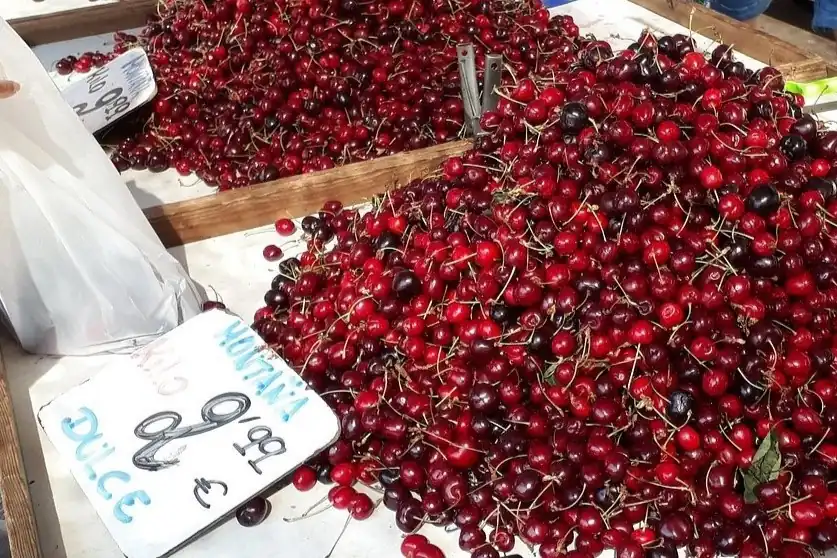Cherry Times Magazine online now! And get your free copy at Macfrut
29 Apr 2025
Pick up a free copy of Cherry Times Magazine at the Berry Area of Macfrut 2025 or browse the 94-page edition dedicated to the international cherry sector online now.
A historic year for the sector: global supply shrinks, while the Southern Hemisphere prepares to seize the moment's opportunities.
The international fresh cherry sector is undergoing an unprecedented transformation. According to the latest report by the United States Department of Agriculture (USDA), published in September 2025, global production for the 2025/26 season (April 2025 - March 2026) will drop by more than 10%, reaching 4.6 million tons.
This is the first global decline in six years, driven by significant production losses in Turkey, Europe, and the United States.

Despite a partial crop recovery in Chile and China, the reduced supply has already triggered a surge in prices in high-consumption markets. The situation worsened in countries traditionally supplied by Turkey, opening the door for alternative exporters ready to claim the vacated market shares.
The Turkish case is emblematic. Once among the top global exporters, the country will see its production drop by 60%, reaching only 400,000 tons. Exports will plummet by 85%, falling to 10,000 tons.
This 56,000-ton gap in global trade cannot be filled by any single player, triggering a seismic shift in global market dynamics.
The European Union also suffered a significant setback, with a 15% drop in production due to frosts in Poland, Greece, and Italy. Imports into the EU collapsed by 60%, down to 23,000 tons.
This is not due to lower demand, but to a forced rationing caused by rising prices and limited availability.
In the United States, production dropped to 403,000 tons compared to 2024/25. To compensate, Washington will increase off-season imports by 25%, up to 30,000 tons, focusing mainly on Chilean cherries.
Meanwhile, Turkish export prices have doubled in the first three months of the season, while domestic prices have hit record highs, prompting producers to allocate nearly 98% of the harvest to the local market.
In today’s tight market, April and October — traditionally critical months for Northern Hemisphere cherry supply — represent a strategic window for producers in the Southern Hemisphere.
The upcoming South American export campaign is expected to benefit from significantly higher prices than last season, provided quality standards remain high.
Amid the chaos, two major players stand out: China and Chile. China remains the world’s leading producer with 900,000 tons, but domestic demand continues to outpace supply.
Imports will hit a record high of 600,000 tons (+8%), driven by the premium segment of the Chinese market.
Chile, on the other hand, plays a starring role. With a record production of 730,000 tons and forecast exports of 670,000 tons (+10%), it positions itself as the natural replacement for the Turkish void.
Its perfectly offset harvest window allows Chilean producers to enter U.S. and Asian markets during peak pricing tension, giving them unprecedented bargaining power.
Despite the global production decline, international cherry trade is expected to remain stable at around 939,000 tons, thanks to Chile’s expansion. However, this numerical balance hides a more expensive and volatile market: less competition, more unpredictability.
According to the USDA, major importers are responding differently:
For producers, the current scenario offers promising prospects, especially for Chile and, to some extent, for new players in Central Asia. However, the heavy concentration of supply in a few countries also creates vulnerability: a major weather event in Chile, for instance, could cause another global price spike.
Lastly, the strategy of Chilean exporters in the Chinese market remains to be seen. Last year, despite high volumes, many reported negative profit margins due to uneven fruit quality during the key January window.
The collapse in global cherry production is not just an agricultural phenomenon, but an economic crisis with global ramifications.
Prices are expected to keep rising in the coming months, especially as Southern Hemisphere supplies enter the market. The risk? That cherries increasingly become a niche luxury fruit, reserved for high-income consumers, leaving much of the market behind.
Source: masp-lmneuquen-com
Image source: Javea
29 Apr 2025
Pick up a free copy of Cherry Times Magazine at the Berry Area of Macfrut 2025 or browse the 94-page edition dedicated to the international cherry sector online now.
07 Mar 2025
A recent study showed that key parameters such as total soluble solids, firmness, and acidity could be predicted with high accuracy, allowing the supply chain to optimize management and improve final quality.
09 Dec 2025
Copefrut introduces RedBeats, a Chilean cherry brand tailored for Gen Z: music-driven identity, flexible packaging and smart formats for every moment. The goal is to turn cherries into a daily snack, moving beyond the traditional gifting-centered consumption model.
09 Dec 2025
A scientific study in Sichuan (China) analyzed two cherry varieties with contrasting colors to understand the genetic regulation of anthocyanin production. The PavMYB.C2 gene and cyanidin-3-glucoside play a central role in developing darker hues. Applications for agriculture and